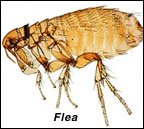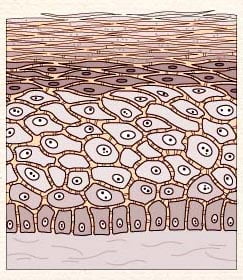Services
MEDICAL SERVICES
Our knowledgeable staff and our facilities allow us to deal with a variety of medical conditions your pet may experience. We hope we do not have to see you or your pet for an emergency but if we do, we are equipped to handle the situation. In some cases, your pet may require hospitalization and further diagnostic tests. Our website describes the medical services we offer in more detail.
Complete Medical Assessment

Flea Control
Seeing many of my clients and their animals are plagued by fleas, I thought it was best to address the flea issue on the website with an informative article about fleas and how to control them.
Flea infestations of dogs and cats and their environment are an ongoing problem for pet owners and veterinarians alike. Flea bites can cause severe itching in some animals and people – especially those that are allergic to them. Vets often refer to the allergy as ‘Flea allergy dermatitis’. To control fleas you need to understand a bit about their life-cycle.

WHAT ARE FLEAS
Fleas are wingless insects 1.5-4.0mm long. Fleas have a laterally compressed body (so if you look at a flea side on, it looks like it’s been flattened ie it’s tall and skinny!) and they have an outer skeleton that is made of chitin (really hard stuff – ever tried squishing a flea?). Fleas are different from lice in that lice are flattened dorsoventrally (ie they are short and fat).
Fleas are not host-specific ie they don’t really care whose blood they suck, therefore a cat flea can infest dogs and vice versa. This also explains why humans get bitten too. Fleas are not fussy when it comes to blood! Strangely enough, large animals like sheep, cattle, goats and horses do not usually have ‘specific’ fleas that are associated with them, although they have been known to be infested by dog and cat fleas.
LIFE CYCLE OF THE FLEA
Note that only the adult flea is parasitic – ie only the adults suck blood and live on the animal. All other stages ie flea eggs and flea larvae are present in the environment. Which explains why you get repeat infestations of fleas despite you having killed all the adult fleas on the animal if you have neglected to get rid of the flea eggs or flea larval stages in their bedding, in the carpet etc…
Adult fleas (on the animal) » hops off animal, female fleas lay eggs in the environment » flea larvae hatch and feeds on organic debris » spins a pupa case (like a caterpillar) » adult fleas emerge from pupa case and hops onto next available animal (which could be you!) and the cycle starts again.
Interestingly enough, adult fleas emerge from the pupal case when stimulated by vibrations – like you walking by, so they can increase their chances of getting onto a ‘food supply’. The rate of development depends on the temperature, hence the pronounced difference in the flea population between seasons – peaking in summer and tapering off in the cooler months.
FLEA BITES
Flea bites on humans are usually small raised singular lumps found near the ankles or feet (where the fleas get on) or can be higher up on the body if it’s the couch they’ve emerged from! People with an allergy to fleas can develop huge welt like reactions which are extremely itchy. Similarly in dogs and cats with flea allergies, the scratching and secondary bacterial infection which could result from it makes life miserable.
FLEA CONTROL
To control fleas we will perfer for you to bring your pets in for a proper diagnostic.
Dentistry
According to the American Veterinary Dental Society, 80% of dogs and 70% of cats have oral disease by the age of 3. It is the most frequently diagnosed health problem in pets. Common signs of oral disease include tartar buildup, red and swollen gums, bad breath, changes in eating or chewing habits, pawing at the face and generalized depression.
A veterinarian should evaluate your pet’s dental health at least once a year. We recommend this because bacteria and food debris accumulates around a pet’s teeth and, if left unchecked, will lead to deterioration of the soft tissue and bone surrounding the teeth. This decay results in irreversible periodontal disease and even tooth loss.

There are other reasons why you should pay close attention to your pet’s dental health. Dental disease can affect other organs in the body: bacteria in the mouth can get into the bloodstream and may cause serious kidney infections, liver disease, lung disease, and heart valve disease. Oral disease can also indicate that another disease process is occurring elsewhere in a pet’s body. A thorough physical exam combined with appropriate laboratory work can determine if this is the case.
We can recommend and demonstrate preventative measures you can begin at home. Our wellness program emphasizes and explains how you can avoid costly dental procedures with your pet in the future.
Radiology (X-rays)
When a pet is being radio-graphed, an x-ray beam passes through its body and hits a piece of radiographic film. Images on the film appear as various shades of gray and reflect the anatomy of the animal. Bones, which absorb more x-rays, appear as light gray structures. Soft tissues, such as the lungs, absorb fewer x-rays and appear as dark gray structures. Interpretation of radiographs requires great skill on the part of the veterinarian.

Tonometry

Dermatology (Skin)
The cause of skin problems range from hormonal disorders to the common flea. You should book an appointment for your animal if you notice any excessive itchy behavior, loss of hair, and / or the presence of scabs or scale on the skin.

Endocrinology (Hormones)
Additional endocrine problems include Cushing’s Disease and Addison’s Disease.
There are many signs observable in pets with endocrine disease. These signs include (but are not limited to) the following: abnormal energy levels, abnormal behavior, abnormal drinking, urinating and eating behavior, excessive panting, skin disorders, and weight gain or loss.

